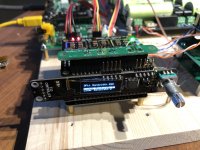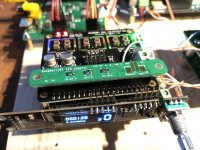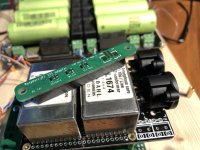Thanks for your answers. Really helpful. I'll see if I can post some high res pictures.For the dac to operate stably with DPLL=1 requires low incoming jitter. All sorts of things can affect jitter, including loose connections where the clocks plug into the clock sockets, bad or noisy connections is pin headers between the stacks of RPi and dac boards, etc. Jitter might not be fully attenuated by the isolator chips typically used for isolation of I2S and I2C signals. Power supply noise/connections can also affect jitter. Since RPi are known to be jittery there could be contributions from more than one source, and a noisy RPi could push the system into failure. Switching power supplies for RPi could have an effect. If using battery power supplies, wires between the dac and the batteries could have bad connections or be too long. A relay with noisy contacts on the battery board could cause problems.
Regarding the location of the controller. When on the dirty side the controller runs on dirty power. It talks to the dac over I2C bus through isolator chip(s). When on the clean side, it runs on clean power and I2C signals do not pass through isolators.
Because there are so many possibly factors that could cause DPLL instability at very low bandwidth settings, it may be hard for Ian to give you an definitive answer to each of your questions.
It might be helpful if you could post high res pictures of your dac and RPi that shows all the boards, power supplies, and interconnection wiring as clearly as possible, maybe that would give people not there with you some ideas about what to try that might help.
ESS9038Q2M DM DSD DPLL locked to DSD128 at the lowest bandwidth=1
@big bird
I may have solution for you.
ES9038Q2M DSD DPLL was designed not as good as PCM DPLL. It's very sensitive to the waveform of input signal. ES9028Q2M DSD DPLL was also confirmed better than.
With this solution, I have not problem locked to DSD128 when set to lowest DSD DPLL bandwidth=1, at sync mode with FifoPi and ES9038Q2M dual mono. Even with supplied XOs.
This solution also explained why you have no problem when plugged the ESS controller into GPIO of dual mono ES9038Q2M.
Please see pictures for details.
Ian
@big bird
I may have solution for you.
ES9038Q2M DSD DPLL was designed not as good as PCM DPLL. It's very sensitive to the waveform of input signal. ES9028Q2M DSD DPLL was also confirmed better than.
With this solution, I have not problem locked to DSD128 when set to lowest DSD DPLL bandwidth=1, at sync mode with FifoPi and ES9038Q2M dual mono. Even with supplied XOs.
This solution also explained why you have no problem when plugged the ESS controller into GPIO of dual mono ES9038Q2M.
Please see pictures for details.
Ian
Attachments
Last edited:
Hi Ian,@big bird
I may have solution for you.
ES9038Q2M DSD DPLL was designed not as good as PCM DPLL. It's very sensitive to the waveform of input signal. ES9028Q2M DSD DPLL was also confirmed better than.
With this solution, I have not problem locked to DSD128 when set to lowest DSD DPLL bandwidth=1, at sync mode with FifoPi and ES9038Q2M dual mono. Even with supplied XOs.
This solution also explained why you have no problem when plugged the ESS controller into GPIO of dual mono ES9038Q2M.
Please see pictures for details.
Ian
I can confirm your solution works. No more lost locks. But because I didn't have a spare raspberry pi adapter I used the ESS Controler extension. Do you have a spare raspberry pi adapter lying around? Or is there another way to achieve the same effect?
I didn't try so low value for DSD DPLL as I already have problem with DSD on default DPLL which manifests as tiny irregular clicking noise and clicking is independent on channels ie not mono, but lock is stable on both channels. I'd like to try this as I have adapter so which is the value of terminating resistors?
@ian,
I'm just curious but what exactly does the adapter do to solve the problem, given that it's not even connected to anything else other than plugged into the GPIO bus?
The reason I asked is that if it improves signal quality then perhaps it could also improve sound quality even if it's not DSD128.
Thanks.
I'm just curious but what exactly does the adapter do to solve the problem, given that it's not even connected to anything else other than plugged into the GPIO bus?
The reason I asked is that if it improves signal quality then perhaps it could also improve sound quality even if it's not DSD128.
Thanks.
Hi Ian,
I can confirm your solution works. No more lost locks. But because I didn't have a spare raspberry pi adapter I used the ESS Controler extension. Do you have a spare raspberry pi adapter lying around? Or is there another way to achieve the same effect?
Good to know all issues are solved. That's great.
I still have some , please let me know what can I help.
Regards,
Ian
@ian,
I'm just curious but what exactly does the adapter do to solve the problem, given that it's not even connected to anything else other than plugged into the GPIO bus?
The reason I asked is that if it improves signal quality then perhaps it could also improve sound quality even if it's not DSD128.
Thanks.
It's all about signal integrity. If we think the digital audio signals in a RF way, GPIO is not a perfect. The adapter board with some termination resistors is for some compensation to the impedance of GPIO to improve the signal transmission quality. I'm not sure if it has business with sound quality, but you can try.
PCM DPLL has already locked to the lowest bandwidth with FifoPi in sync mode. Please let me know if you have new update.
Regards,
Ian
I guess it's a little like the older days SCSI cabling where we had to put in a termination at the end of the chain to stop "mirror effect"? It still worked without the termination in some setup but could cause issues.
What resistor values did you use?It's all about signal integrity. If we think the digital audio signals in a RF way, GPIO is not a perfect. The adapter board with some termination resistors is for some compensation to the impedance of GPIO to improve the signal transmission quality. I'm not sure if it has business with sound quality, but you can try.
PCM DPLL has already locked to the lowest bandwidth with FifoPi in sync mode. Please let me know if you have new update.
Regards,
Ian
What resistor values did you use?
For compensation, the resister values will be up to the real situation of the GPIO connector load and PCB trace impedance of the real application. They could be in a range of 100 to 500 ohm. I use 200 ohm 0402 chip resistors in the picture and they work fine. You could try some thing else for better result. Resistors in 0603 package are also good for easier soldering.
Regards,
Ian
Stupid question: in the IAN DAC there are 3 power rails:
DVCC: that i suppose to be Digital Voltage Input
AVCC: That I suppose to be Analog Voltage Input
But
What is VCCA ?
DVCC: that i suppose to be Digital Voltage Input
AVCC: That I suppose to be Analog Voltage Input
But
What is VCCA ?
VCCA is for the async clock.
That's not needed when run in true-sync mode. I tried not giving it power and the DAC still works. However the sound is not as good so I leave it on.
That's not needed when run in true-sync mode. I tried not giving it power and the DAC still works. However the sound is not as good so I leave it on.
@jacklee, I bet what you found about powering VCCA has to do with how the clock acts when it is disabled versus when it is un-powered. Can anyone who knows more about how clocks work weigh in?
@Rrbs, I just pointed an Apple Remote or copy at the controller and clicked. Nothing more magical than that. What have you tried?
Greg in Mississippi
@Rrbs, I just pointed an Apple Remote or copy at the controller and clicked. Nothing more magical than that. What have you tried?
Greg in Mississippi
Can anyone who knows more about how clocks work weigh in?
Clocks are considered as being analog, not digital. VCCA is the high frequency analog power supply. ESS eval boards put the clock and VCCA on the same voltage regulator.
@Rrbs, I just pointed an Apple Remote or copy at the controller and clicked. Nothing more magical than that. What have you tried?
Greg in Mississippi
Hi Greg I haven't tried anything but I think I should do something like pairing the apple remote up with the DAC like computer. Today I finished assembling the DAC and found that there is no need to do anything . You are correct . Thanks for the information .
- Home
- Source & Line
- PC Based
- ES9018K2M, ES9028Q2M, 9038Q2M DSD/I2S DAC HATs for Raspberry Pi


